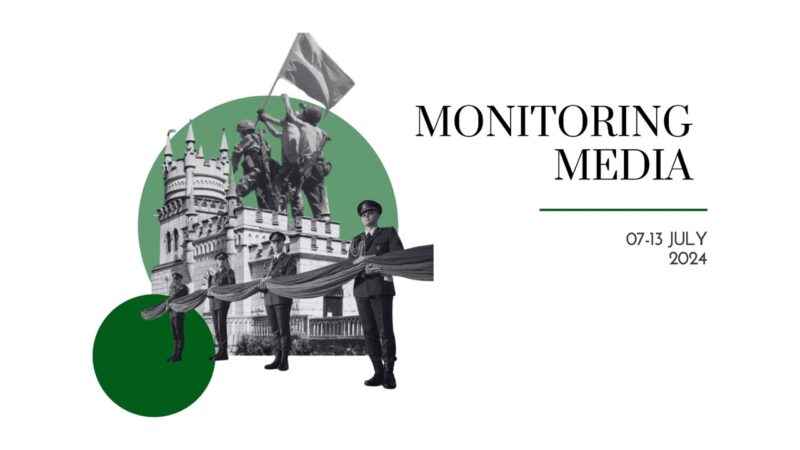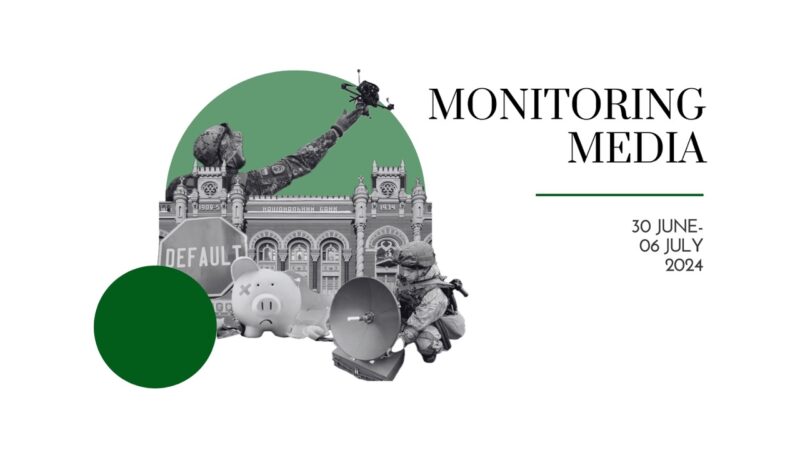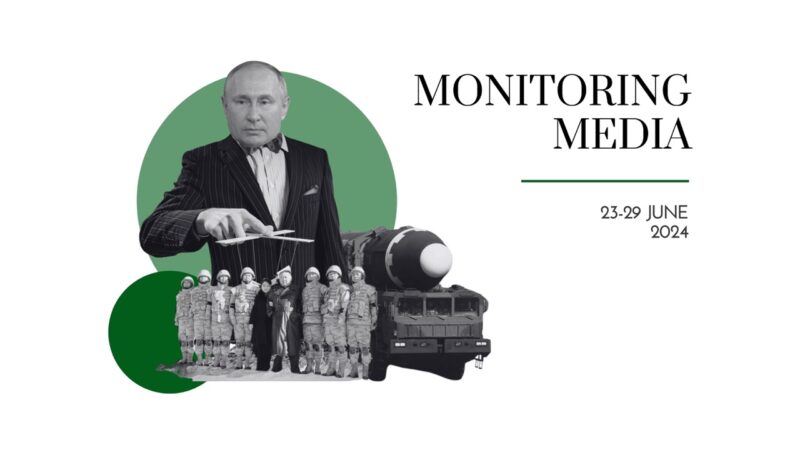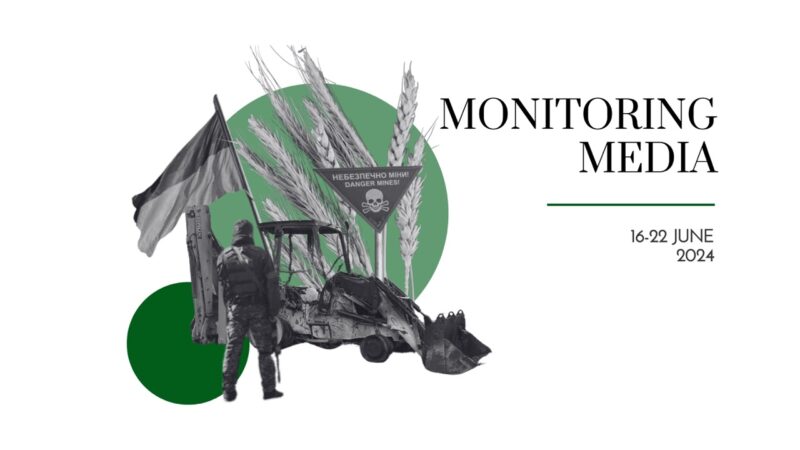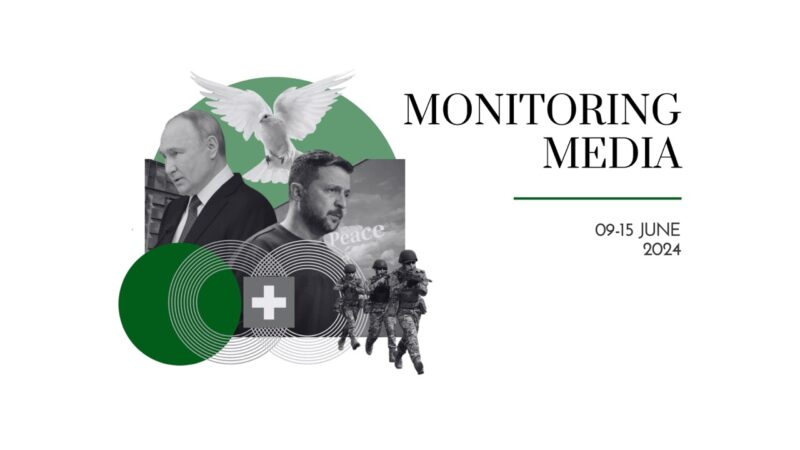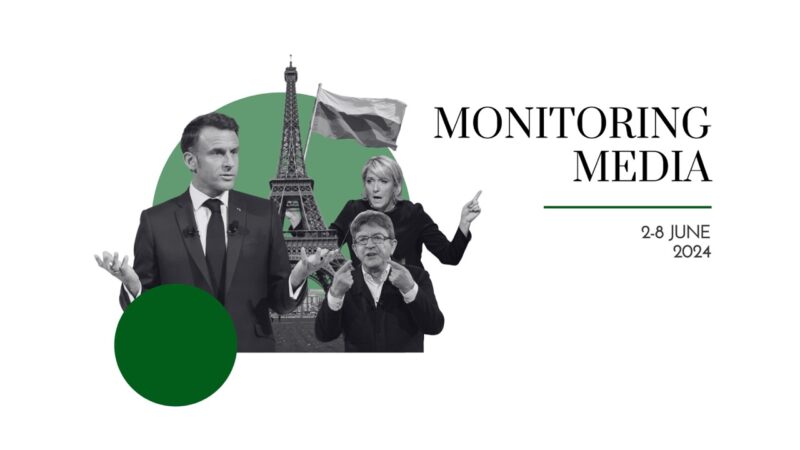Wagner’s mutiny creates new opportunities for Ukraine
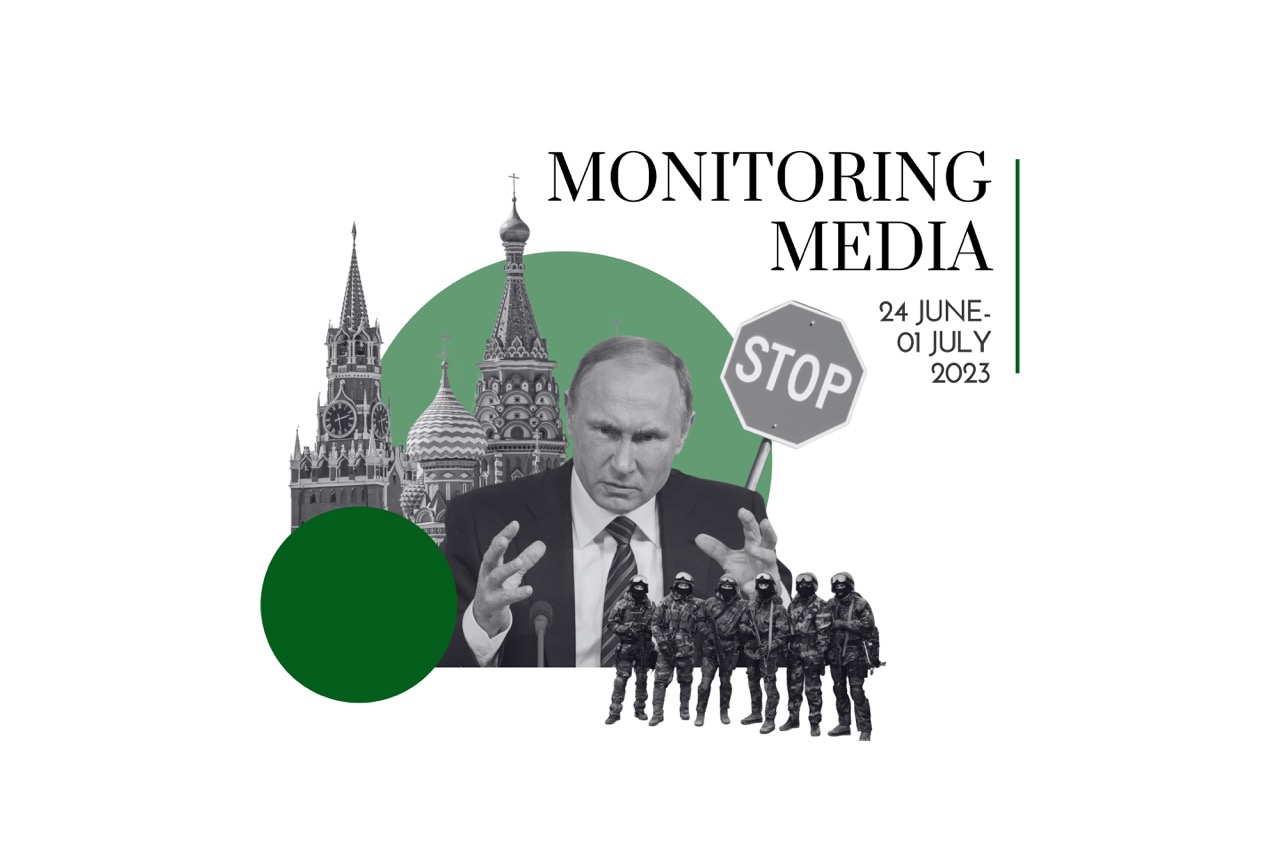
CIUS weekly report on North American media coverage of Ukrainian affairs, 24 June–1 July 2023
Two publications (Atlantic Council and The National Interest) were selected to prepare this report on how the situation in Ukraine has been portrayed in the North American press during the past week (24 June–1 July 2023). The sample was compiled based on their impact on public opinion as well as on their professional reputation, popularity among the readership, and topical relevance. These two publications represent centrist and conservative viewpoints on the political spectrum.
This report covers only the most-read and relevant articles about Ukraine, as ranked by the respective North American publications themselves in the past week. Its scope covers promoted articles on home pages and articles from special sections on Ukraine, with the hashtag #Ukraine, from the paper editions of the publications, and about Ukraine from opinion columns and editorials.
Topics featured in the selected articles:
- Ukraine’s current affairs: Ukraine could liberate Crimea without major fighting;
- The world and Ukraine: the West should rebuild Europe’s security architecture and further change its policies vis-à-vis Russia; US support for Ukraine likely to remain high for the future;
- Russia at war: Wagner’s mutiny weakened the Russian army and created new opportunities for Ukraine on the battlefield; relocation of Wagner fighters to Belarus poses a new danger for the whole region; Wagner’s mutiny shocked Putin and threatened his power hierarchy.
Main arguments:
Ukraine’s liberation of Crimea will be easier if it blocks the Russian naval base in Sevastopol. John B. Barranco (Atlantic Council) argues that “it would be militarily foolish for Ukraine, as part of the counteroffensive that is now underway, to charge into the Russian-occupied peninsula. Instead, there are ways for the Ukrainians to render Crimea strategically irrelevant militarily to their Russian foes.” In the first place, Barranco suggests that the Ukrainian army should start inflicting a high price on the Russian Black Sea Fleet every time its vessels attempt to leave the Sevastopol harbour. This can be achieved by deploying advanced naval mines, Neptune anti-ship missiles, and unmanned vehicles (or sea drones). When the F-16 fighter jets contributed by the West join the battlefield, they can also be used effectively to prevent the harbour from operating. With its naval power contained, Russia will have much less strategic interest in staying in Crimea or defending other military objects there. On the other hand, Ukraine will suffer very high casualties if it initiates a massive on-land assault and tries to cross the narrow isthmus that connects the peninsula to the mainland. The author also provides an overview of how Ukraine’s counteroffensive has developed so far. In particular, Ukrainian forces are attacking along a broad front, aiming to probe Russian lines, masking their tactics, and strike the weakest points; Ukrainian combat engineers are spending a lot of time clearing mines and tank obstacles, often under artillery fire, which slows the pace of the counteroffensive; Ukraine’s objective is to reach “the rear area of Russia-occupied territory and split the Russian force in two with a combination of armor and HIMARS strikes guided by unmanned aircraft systems.” Barranco concludes: “While the current Ukrainian counteroffensive is a welcome step toward victory in this war, it will be one of many campaigns over the course of what will likely be a long and arduous struggle.”
It behooves the West to reconstruct Europe’s security architecture and compel Russia to de-imperialize. Former Ukrainian prime minister Arseniy Yatsenyuk (Atlantic Council) outlines five steps that the West and Ukraine must take toward victory and any possibility of lasting peace with Russia. The first step resides in arming Ukraine sufficiently for victory, with an emphasis on quantities and timing of deliveries: “Every single delay in military aid costs Ukrainian lives and emboldens Russia.” Second is the strategic deterrence of Russia and the creation of a new, NATO-centered security architecture in Europe. Yatsenyuk argues that Ukraine should eventually become a full-fledged member of the alliance, because no alternative bilateral arrangements can ever replace Article Five or keep Russian expansionism at bay. The third step envisages “Ukrainian membership of the European Union and restoration of the Ukrainian economy, in close unison with the wider European economy.” The fourth resides in neutralizing Russia’s potential to act aggressively by intensifying sanctions and preventing the transit of dual-purpose goods through the aggressor state. Russia’s sources of money to finance its war machine must be closed off. The final step is Ukraine’s genuine victory, which should lead to the Kremlin revising its imperialist nature. This step is one of the hardest to achieve: “Unless the underlying issue of Russian imperialism is addressed at the international level, the liberation of Ukraine will provide little more than temporary relief… Russia must bear full legal and financial responsibility for its aggression against Ukraine and for the genocide of the Ukrainian nation. The era of Russian impunity for war crimes must end.” Apart from that, Yatsenyuk writes that during his tenure as prime minister of Ukraine he had approached many Western decision makers, highlighting potential threats coming from Russia, and encouraged them to develop a strategy toward Eastern Europe. Yet their response was often insubstantial—which, according to Yatsenyuk, encouraged the Kremlin to carry out the full-scale invasion of 2022.
US support for Ukraine’s war effort is unlikely to wane. Leon Hadar (National Interest) responds to the Harper’s article “Why Are We in Ukraine” by Benjamin Schwartz and Christopher Layne, who strive to “provide a coherent and convincing case against US involvement in the war in Ukraine.” Hadar argues that it is inappropriate to define the Russo-Ukrainian war as a US “proxy war” and compare it to the one in Vietnam: “Unlike that war in Southeast Asia, where close to 60,000 American service members lost their lives fighting, there are no American troops engaged in combat in Ukraine.” Also, until Ukraine joins NATO the US has no obligation to defend it directly, yet it can continue delivering ammunition—a policy which has bipartisan support in Congress and enjoys high public legitimacy. According to Hadar, arming Ukraine today can be compared to arming Israel in the 1950s and afterwards. On the one hand, long-term support for the newly established Jewish state appeared costly for the US in the long run. On the other hand, “at no point in the seventy-five years of close cooperation between Washington and Israel has America been drawn into a direct military intervention in the wars between the Israelis and the Arabs—or with Soviet Russia, the former patron of Egypt.” Hadar also points out that popular support for US engagement in any conflict overseas directly depends on the number of soldiers the US army loses there. In Ukraine, no American soldier has been killed, which bolsters the legitimacy of Ukraine’s war effort and is likely to do so for the longer term. Hadar concludes: “A Ukraine that continues to be seen by America as a nation fighting for its survival against a U.S. adversary is more likely than not to continue to benefit from U.S. assistance … Critics of the Biden administration’s Ukraine policy, therefore, face a major challenge in trying to change public and congressional attitudes, as long as the United States itself is not drawn directly into the fighting there.”
Between 24 June and 1 July the Atlantic Council dedicated a large number of articles to analyzing the mutiny of Yevgeniy Prigozhin and his Wagner mercenary group against the central government in the Kremlin. The mutiny took place on 23–24 June 2023; it was short-lived but very dynamic.
Wagner mutiny charts new opportunities for Ukraine on the battlefield. Andriy Zagorodnyuk (Atlantic Council) argues that Ukrainians have many good reasons to cheer Wagner’s short-lived mutiny in Russia and appreciate its reverberations. Primarily, the Kremlin is very likely to put an end to the Wagner mercenary venture as an independent military force: “Individual units will either be broken up, exiled to Belarus, or integrated into the regular Russian army.” This will be done to publicly punish traitors, who represent a threat to Putin, as well as to mitigate the probability of new similar unrests. At the same time, even if they decide to join the Russian army, Wagner fighters will suffer from low morale because they will never again enjoy the trust of the state. Secondly, with one of the most effective Russian military units out of the game, the invading army will have ever fewer options to advance with. Therefore, Ukraine’s command should seize the opportunity and intensify its counterattack—especially around Bakhmut, where earlier Russian gains were secured thanks to the Wagner mercenaries. Thirdly, the mutiny and its lightning “advance” toward Moscow demonstrated that the Russian inland is very poorly defended. All of Russia’s military-capable units have been deployed to Ukraine, and no reserves remain—even around the capital. In this light, cross-border raids of Ukrainian-backed Russian militias may become even more daring and successful in the future, leading to deeper penetration compared to those in Belgorod oblast in spring 2023. Finally, the Wagner mutiny unveiled numerous weaknesses and divisions within Russia: “Members of the public in Rostov-on-Don and elsewhere appear to have enthusiastically backed the rebellion, while others were indifferent. The limited military presence inside Russia made no serious attempts to intervene, while there was little indication of any surge in public support for Putin or condemnation of Prigozhin.”
As did Zagorodnyuk, Peter Dickinson (Atlantic Council) argues that Ukraine can reap benefits for itself from the recent events. Dickinson claims that the outcome of the Wagner mutiny turned out favourably for Prigozhin and hard to deal with for Putin: “The details of the deal struck between Prigozhin and the Kremlin remain murky, but the Russian warlord appears to have emerged from the drama relatively unscathed, at least for now. The same cannot be said for Vladimir Putin, who has been very publicly humiliated by the affair and now looks weaker than at any point in his twenty-three-year reign.” To that, Dickinson adds that the mutiny and its aftermath eroded Russia’s war effort, with around 20,000 of Wagner’s most experienced fighters withdrawing from the Ukraine battlefield. While many of them might return to the corporation, “the days when Wagner troops led the Russian invasion of Ukraine look to be over.” The mutiny also demonstrated the lack of domestic defences within Russia, which can be deduced from the uninterrupted 200-km-long advance of Wagner’s armoured column toward Moscow in less than 24 hours. In the nearest future, to Ukraine’s benefit, the Kremlin will likely redeploy some of its troops inland, in order to reinforce control over the domestic situation, and start a hunt for traitors in the Russian military command. Speaking of Putin, his image as a strongman took a major blow, which seriously affected his public loyalty. Above all, this will negatively impact confidence in Russian leadership among their soldiers in the trenches: their battle morale will further deteriorate, and questions about the necessity of the war will surface. Dickinson concludes: “The Wagner mutiny is further proof that Putin’s disastrous invasion of Ukraine has left Russia divided, demoralized, and weakened. With his own personal authority now rapidly evaporating, the Russian dictator may soon face domestic problems so grave that they will overshadow even the prospect of defeat in Ukraine.”
Relocation of Wagner fighters to Belarus is worrisome, above all for ordinary Belarusans. Hanna Liubakova (Atlantic Council) argues that “Belarusian dictator Alyaksandr Lukashenka appears eager to take full credit for his role in countering Russia’s short-lived but hugely significant recent Wagner rebellion.” During a press conference on 27 June, Lukashenka boastfully highlighted his efforts to curtail the advancement of mutinous mercenaries toward Moscow, thereby contrasting his own strong leadership with Putin’s apparent indecisiveness. However, according to Luibakova, Lukashenka might have simply been playing the role of Kremlin messenger, given that Putin had announced Prigozhin as a traitor and therefore he could not negotiate with him directly. The relocation of the Wagner mercenaries to Belarus, which Lukashenka is very proud of, may also be a sign that “Belarus [has become] a vassal state of Russia that serves as a place of exile for disgraced members of the Kremlin elite.” In turn, ordinary Belarusians are concerned that with Wagner being deployed in their vicinity, the country will be further dragged into Russia’s war-related turmoil. Not to mention that apart from Wagner, the Kremlin had earlier resolved to move part of its nuclear arsenal to Belarus. Considering all these decisions and developments, Liubakova concludes that Belarus is an important token in Russia’s security game—specifically, in creating pressure on the eastern flank of NATO and Ukraine. Lukashenka’s personal gains, above all, reside in using the Wagner fighters “as a means of protecting himself against any form of domestic opposition.”
Prigozhin’s mutiny became Putin’s personal nightmare and unveiled his weakness. Taras Kuzio (Atlantic Council) writes about the outcomes of the mutiny and argues that it discredited the image of Vladimir Putin as a tough political strongman: the inability of the president “to punish mutinous troops who seized a major Russian city and marched on Moscow has revealed him as a weak leader who is more inclined to capitulate than escalate.” In this light, Western allies of Ukraine should finally stop being afraid of provoking Putin and further increase their support to the defending army. Kuzio argues that Putin has a habit of backing down every time he finds himself confronted by a determined adversary. While the annexation of Crimea in 2014 was completed decisively and swiftly, the occupation of Donbas evolved into a frozen conflict as just Ukrainians mounted a strong resistance. There was no response from Putin when Turkey shot down a Russian jet in 2015 over Syria. When the Russian invasion of Ukraine started in 2022, Putin was sure of a quick victory, yet today resorts to nuclear blackmailing of the West to achieve his objectives. Last week, regardless of the fact of mutiny and the loss of a number of aerial military vehicles, Putin revoked all charges against Prigozhin and his mercenaries. Kuzio opines that throughout his years in power Putin has aimed to create a political environment where any mutiny would be impossible; therefore, his regime is built on personal loyalty. Prigozhin’s mutiny—although not widely supported by the public or within the ranks of the Russian military and security services—became the worst possible outcome of Putin’s decades-long efforts. Kuzio concludes that the Russian elites “understand that Putin has lost his legitimacy as a strongman ruler and is leading Russia toward an uncertain future of deepening domestic divisions and international isolation. Understandably, thoughts are now turning to the post-Putin era.”
